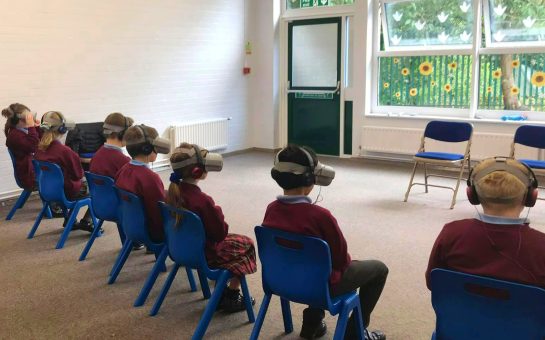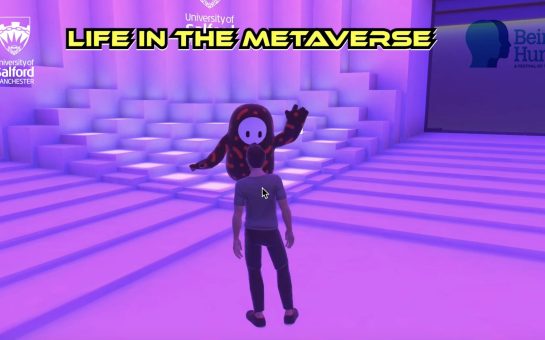When, in 1983, the final specks of vision receded from John Hull’s eyes, he found his dreams haunted by recurring nightmares where, trapped in a coal truck, he plunged deep into the depths of a mine shaft, staring up as the light above him shrunk to nothing.
Just a week before one final operation failed to repel the widening black circles reaching across his vision, condemning John to complete blindness, John’s son was born – one of five children whose faces John cannot know.
The first years of John’s blindness were consumed with trying to cope with the practical challenges it presented, readapting to simple tasks such as navigating from his house to his office, communicating with his colleagues and strangers and coping as a blind father.
During this time John’s only access to the visual world continued to taunt him as he slept, the dreams of the coal mine mixed with visions of crashing waves sweeping his family away.
John’s story captured the imaginations and intrigue of filmmakers Peter Middleton and James Spinney, whose film, Notes on Blindness, and its accompanying virtual reality experience, Notes on Blindness: Into Darkness are now touring UK cinemas, having premiered at this year’s Sundance Festival.
John, a professor of theology at Birmingham University, resolved that if he didn’t endeavour to surpass his furious denial and come to understand his blindness, it would defeat him.
It is this period of self-discovery that is captured in the film.
Not wanting to burden his family with the weight of his loss, John opened his world into a diary of audio recordings into which he poured his experiences.
His sightless world began to widen again as he sought the meaning of blindness.
“John noted this neurological rewiring whereby his brain no longer hungered for the visual. He said he was able to move from being a blind person with a sighted person’s brain to being someone who lived in the reality of total blindness,” said filmmaker Peter.
“That’s what led to his period of introspection, this excavation of the blind experience and keeping the diary was integral to that: it was his way of communicating the experience,” Peter said.
The tapes, recorded over three years between 1983 and 1986, charted John’s transformative journey from sighted man to blind man through the initial grief of his loss to the deep philosophical and spiritual discoveries he would later make.
By the end of the three years, John had amassed 16 hours of recordings that would go on to become the key basis for his 1990 book, Touching the Rock.
Author and neurologist Oliver Sacks praised Touching the Rock and has written extensively about John’s adjustment to what he calls ‘a world beyond sight.’ A world that John viewed a positive one.
As time went by, his ability to remember the faces of loved ones faltered and his visual connection to them faded – John’s eldest daughter was just 7 when he lost his sight so any memory he had of her was becoming increasingly inaccurate with each passing year.
Listen to an extract from John Hull’s audio diary from June 1983, titled ‘A note on weather’. #NotesOnBlindnesshttps://t.co/WS4fuK8Pdl
— Notes on Blindness (@OnBlindness) June 30, 2016
The film focuses on how instead letting blindness define him negatively or falling into a deep depression, as he may have been forgiven for doing, John seized the opportunity and embraced his new reality.
It was he that would define his blindness and not the other way around.
John’s discovery of his new self in the film centres largely on a pivotal scene when, one New Year’s, John awakens to a new depth in the world around him.
The scene provides a romantic representation of the steady transformation process John went through.
“For the first time, he felt like he was being addressed by the world and that he was an active agent in his environment and that led to a deeper level of enquiry into the impact of his senses on his perceptive world,” said Peter.
John spoke a lot about the predominance of the visual in society and how, in spite the common belief that blindness causes other senses to improve, his loss of sight initially threw his other senses into disarray.
Though, once he achieved greater comfort with his blindness, John gained a greater ability to tune his other senses to the world, his blindness left him feeling vulnerable in a way that he’d never been before.
Notes on Blindness is a masterpiece. pic.twitter.com/eQhoMH1snn
— Cate Kane (@filmgirlcate) June 30, 2016
Peter said: “John always spoke about what he found in blindness was actually what he came to describe as a gift that gave him a new understanding and new way of being in the world.
“It’s so difficult to speak on behalf of him because he was such a highly intelligent man, but I think something he was talking about was the gift of vulnerability and marginalisation that he experienced in blindness.
“He understood what it meant to be vulnerable and that enabled him to find a connection with other people who are marginalised or disadvantaged.
“He had a very broad set of interests and it was this understanding that he gained through the vulnerability of blindness that enabled him to position himself.”
Though John spoke widely on blindness and disability, he often described blindness as a hobby.
He was as much engaged with social justice and once he was even arrested while campaigning for nuclear disarmament.
The filmmakers worked closely with cinematographer Gerry Floyd in an attempt to work against the visual nature of film in an attempt to evoke something of the blind experience and John’s rediscovery of the beauty of cognition.
The framing of supporting characters, particularly of the children that John never saw– who are always framed beneath the mouth, as silhouettes or through obscure translucent surfaces – were key to this.
Meanwhile, Peter says a conscious effort was made to try to close down the space in shots – never showing clean shots or giving the audience a sense of wide spacial geography – to suggest something about the reduction of John’s world through blindness.
However, one of the most intriguing elements of the film is the use of the original audio from John’s tapes, which the on-screen actors – Dan Skinner as John and Simone Kirby as John’s wife, Marilyn – lip-sync along to, as a means of preserving the immediacy and authenticity of John’s world.
Watch an exclusive clip from the astonishing #NotesOnBlindness – out tomorrow! https://t.co/hKwODjuflu @OnBlindnesshttps://t.co/97iMCVuGN1
— Artificial Eye (@ArtificialEye) June 30, 2016
“We knew from very early on that there as a very compelling story in there from a position of grief and loss, rebirth and transformation and we knew that there was potential based along these audio cassettes.
“He had this fantastic wealth of audio archives from the period. John’s account is such an internal one – it’s one set so much in the interiority of the blind experience, in dreams and memories,” said Peter.
Along the way John and Marilyn unearthed a lot more material, finding additional tapes that John had recorded in the 1980s – he would often set up audio recorders around the house on special occasions: on birthdays, Christmases and family occasions.
Peter added how integral John and Marilyn had become in the production of the film, which was why John’s death in July 2015 – a couple of months after celebrating his eightieth birthday and just two weeks after Notes on Blindness started filming – came as such a crushing blow.
“John had had a couple of health problems before that, but he was actually in quite good health just before he passed away. We’d seen him just a few weeks earlier.
“It was very sudden and very difficult for everyone involved and it certainly reframed the project in the sense of trying to do justice to John’s story.
“It was difficult for James and myself as we’d come to see John as a collaborator in the project, we’d spent a lot of time working through the material with John and Marilyn and we’d grown quite close.
“We never really considered that he wouldn’t be here by our side to present it to the world.”
Fantastic to hear James Spinney speaking about ‘Notes on Blindness’ – really can’t wait to see the full film #eeffindustry
— Bea Moyes (@BeaMoyes) June 21, 2016
Notes on Blindness’ release will be accompanied by a number of other projects, including the Impact Campaign under which directors Peter and James have sought new methods of reaching out to blind, short-sighted or hard-of-hearing audiences.
The film’s soundtrack will be accompanied with an option for what they call enhanced sound design, which, rather than using an external narrator as with audio description, brings in more description from John and Marilyn to guide the story.
Peter said: “This has been an interesting creative challenge for us for the past couple of months.
“It’s not necessarily literal description of what is on the screen but their narration tonally coheres with the film and effects and music to guide audiences through the film with sound.
“In fact, the way we’ve gone about editing it was to turn off the picture and try to edit a ninety minute sound piece. It’s all very experimental and we’re very open to people’s feedback on that.”
The Impact Campaign has also worked with the Royal National Institute of Blind People (RNIB) to launch an accessibility app which allows audiences to get audio description to their smart phones regardless of where they’re watching.
Notes on Blindness comes accompanied by sister project Notes on Blindness: Into Darkness, a virtual reality experience which utilises binaural audio and 3D visualisations to recreate the pattern of human movement as a means of demonstrating the blind experience.
Notes on Blindness and Notes on Blindness: Into Darkness began their UK tour on July 1 and play at HOME on 2 July.
For more information, click here.
Image courtesy of Open City Documentary Festival, via YouTube, with thanks.

